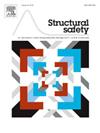Stochastic modelling of non-stationary and dependent weather extremes for structural reliability analysis in the changing climate
IF 6.3
1区 工程技术
Q1 ENGINEERING, CIVIL
引用次数: 0
Abstract
In recent times, the safety of infrastructure systems has been challenged by the increasing severity of extreme weather events caused by the effects of climate change . This trend is expected to continue, as shown by the simulations of future climate conditions under high-emission scenarios. The paper presents a general stochastic process, known as the Linear Extension of the Yule Process (LEYP), to model the non-stationary frequency and intensity of extremes. The LEYP model overcomes a major limitation of the classical Poisson process by including the statistical dependence among extreme events.
The paper presents a probabilistic framework for non-stationary structural reliability analysis, which includes new results for the return period, waiting time for the next event, correlation coefficient, and the distribution of the maximum load in a given time interval. The examples provided in the paper demonstrate that even a modest degree of dependence can significantly reduce the interval between events and increase the probability of failure with time. Furthermore, the paper illustrates the non-stationary modelling of future precipitation data, as simulated by the Canadian Earth Systems Model (CanESM5). The results of this study are expected to be useful for revising current ”stationary” design codes and ensuring structural safety in the changing climate.
气候变化中结构可靠性分析的非平稳和相关极端天气随机建模
近年来,由于气候变化的影响,极端天气事件日益严重,基础设施系统的安全性受到了挑战。正如在高排放情景下对未来气候条件的模拟所显示的那样,预计这一趋势将继续下去。本文提出了一个一般的随机过程,称为Yule过程的线性扩展(LEYP),来模拟极端事件的非平稳频率和强度。LEYP模型克服了经典泊松过程的一个主要限制,它包含了极端事件之间的统计依赖性。本文提出了一种非平稳结构可靠性分析的概率框架,该框架包括回归期的新结果、下一次事件的等待时间、相关系数和给定时间间隔内最大荷载的分布。文中给出的例子表明,即使是适度的依赖也能显著减小事件之间的间隔,并随时间增加故障的概率。此外,本文还举例说明了由加拿大地球系统模式(CanESM5)模拟的未来降水数据的非平稳模式。本研究的结果有望对修订现行的“固定”设计规范和确保结构在不断变化的气候下的安全有用。
本文章由计算机程序翻译,如有差异,请以英文原文为准。
求助全文
约1分钟内获得全文
求助全文
来源期刊

Structural Safety
工程技术-工程:土木
CiteScore
11.30
自引率
8.60%
发文量
67
审稿时长
53 days
期刊介绍:
Structural Safety is an international journal devoted to integrated risk assessment for a wide range of constructed facilities such as buildings, bridges, earth structures, offshore facilities, dams, lifelines and nuclear structural systems. Its purpose is to foster communication about risk and reliability among technical disciplines involved in design and construction, and to enhance the use of risk management in the constructed environment
 求助内容:
求助内容: 应助结果提醒方式:
应助结果提醒方式:


